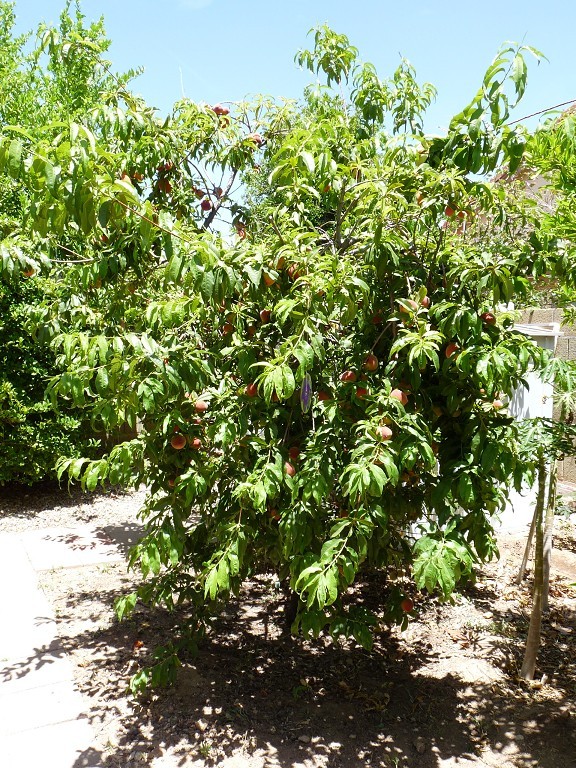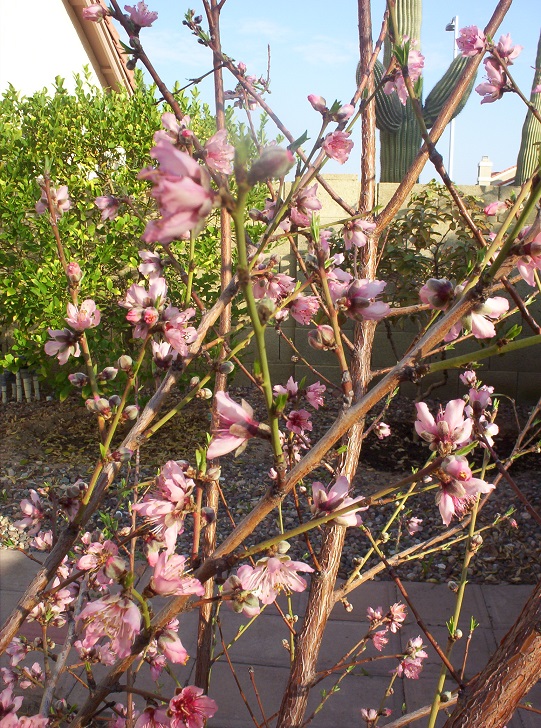|
 Photo
Photo
The photo on the right is of an Earli Grande peach tree and was taken in the middle of
May. This tree was planted bare rooted about a year and a half earlier in January.
Being located on the East side of the house, at a distance of about twelve feet,
the tree receives late afternoon shade. The peaches are medium to large in size and are semi-freestone
with an excellent flavor and texture. Flowers on an Earli Grande are pink.
Overview
Peaches are relatively easy to grow in the lower desert if a variety well adapted to
the hot arid climate is chosen. The best two varieties for the Phoenix area are
Earli Grande and Florida Prince. They can take full sun, but it is recommended to
give them afternoon shade the first summer. Cold weather is not a problem because
peaches are deciduous.
Food Uses
Peaches can of course be eaten fresh, and are also great for salads and pies. Unfortunately, peaches do not
keep very long once picked and the whole crop becomes ripe on the tree within several weeks.
Plan to refrigerate part of your crop immediately after picking. Peaches can also be
frozen
for later use.
Heat Tolerance and Sun Exposure
The key to successfully growing peaches in the lower desert is choosing
the right variety. Peaches need a certain number of chilling hours,
time below 45 degrees Fahrenheit, to produce
fruit and stay healthy. The majority of peach varieties will not produce in Phoenix
because there is not enough cold in winter. Luckily, there are a few varieties
that do very well. The best varieties are Earli Grande and Florida prince. Desert
Gold and Bonanza will also produce here but their fruits are smaller and their
flavors are not as good. Peaches can take full sun once they are established but
are happier with some afternoon shade. Afternoon shade is recommended for the
first year after planting.
Cold Tolerance
Peach trees are deciduous and can take temperatures well below freezing.
Planting
It is best to plant bare rooted trees while they are dormant in January. Trees
in a pot should be planted in late fall so that they have sufficient time to
grow roots before summer. It is better not to plant the tree in the grass.
However, if you do so, dig out a large circle of grass around the planting hole
to keep the grass from competing with the tree.
The hole for the tree should be at least twice the size of the rootball.
At a minimum, make the hole 2 feet in diameter and 2 feet deep.
Back fill the whole with the same native soil that was removed.
It also is a good idea to finish with the
hole an inch or two recessed so that a watering basin is formed.
After planting, spread a thin layer of compost on top
of the soil to help conserve moisture and to supply some nutrients.
Do not fertilize the newly planted tree until it has been vigorously growing for
a couple of months.
Bare rooted trees should be tied to a solid stake for support. Potted
tries might also need to be staked depending on their dimensions.

Watering frequency
Peach trees do well on a grass watering schedule year round. Although,
they can handle getting even less water in the winter than a grass schedule provides because they are dormant.
Watering method
Basin or flood irrigation
is recommended because it helps keep the salt in our salty
water from accumulating around the roots. Furthermore, deep watering
will encourage the plant to develop deeper roots, making the plant tougher when the weather
gets hot and dry.
Fertilizing and Growth Rate
Do not fertilize the tree the first year. This will encourage its roots to
go looking for food.
After the first year, lightly
fertilize the tree with a balanced chemical or organic fertilizer, below its drip line,
once in early February, before bud break, and again in early June, after fruiting is complete.
Pruning
Peach trees are fast growing and should be pruned during the winter.
Peaches emerge on new growth, so if the tree is not pruned the peaches
will emerge further away from the trunk every year, eventually putting
heavy strain on branches, potentially breaking them. Furthermore, a peach
tree can get very big so pruning will keep it a manageable size.
On mature trees, it is recommended to remove 2/3 of new growth
every winter from the previous summer. This can
be done by a combination of heading back branches and removing branches.
Always remove any branches coming from below the graft point or from the roots
because these branches are coming from the rootstock and will not produce good
fruit.

Propagation
Only a grafted tree will produce fruit identical to that of its parent.
Pests
Birds can get all of the peaches unless measures are taken to discourage them.
Hanging old computer or music cd's to the tree is very effective. The
dancing relections from the shiny side of the disks spook the birds.
Life Span
Unfortunately grafted peaches seem to be short lived trees with a life span of about 15 to 20 years. You will be able to tell
your tree is getting old because the peach crop will suddenly become significantly smaller and will be
concentrated only on the ends of the newest branches. Once a tree gets old it goes down fairly quickly, dying in large
sections until there is nothing left.
Links to more Peach information
Peaches and more fruit at University of Arizona
Peaches at Utah State University
|
 Book the Phoenix Tropicals Condo on Kiahuna Beach, in Kauai, Hawaii
Book the Phoenix Tropicals Condo on Kiahuna Beach, in Kauai, Hawaii